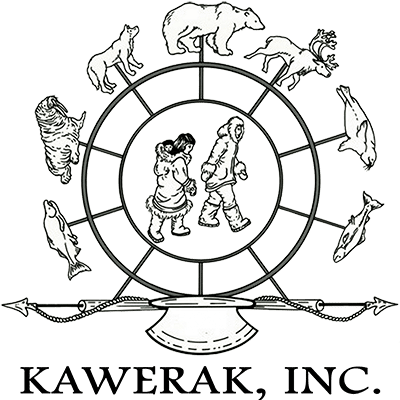What drew you to the Caleb Scholars Program?
As a Caleb Scholars Program Fellow, I contribute to a cohort of Alaskan Inuit in fields related to conservation, responsible development, the protection of subsistence rights and cultural heritage, and an increase in the number and visibility of strong Alaskan Inuit leaders. Learning about the Caleb Scholars Program and its support for Inuit-led conservation helped me realize that I didn’t have to choose between Western science and my Inupiat identity. I could braid them together, carrying our values forward while engaging in new ways of understanding the world. Bringing my whole self into academic spaces has been a journey, but the legacy of Caleb Pungowiyi has made it possible.
What does Inuit-led environmental conservation mean to you?
To me, Inuit-led environmental conservation means empowering Arctic communities to advocate for our ancestral lands so that our ecosystems can thrive. Our stewardship is rooted in generations of knowledge, as we are the original scientists of these lands and waters. When we bring our traditional ways of knowing into conversation with Western science, we can contribute meaningfully to the protection and sustainability of our environment.
From a young age, we are taught to care for our land, animals, people, and resources. This responsibility is deeply ingrained in our identity. It’s why strong Inuit and Indigenous mentors, leaders, and supporters are so important, especially for youth. We deserve a seat at the table where decisions are made about our future, including in academic and governmental spaces. Advocacy for our marine habitats must reflect the knowledge and voices of the people who have lived in harmony with them for generations.
How do you engage with environmental conservation in school and/ or at home?
I have been invited by Dr. Erik Schoen of the International Arctic Research Center (IARC) to join the Climate Adaptation Science Center (CASC) project titled “Research to Action for Yukon River Salmon: Adapting to Climatic, Food-Web, and Habitat Changes.” As a master’s student on this project, I am now entering graduate school with a renewed focus on co-production of knowledge, science communication, and meaningful community engagement. This opportunity reflects a natural evolution of my educational goals, from broad interdisciplinary learning to more focused, actionable research that directly serves Indigenous communities and ecosystems.
My commitment to fostering respectful and collaborative research partnerships with tribal communities remains at the heart of my work. Through this project, I aim to address critical concerns related to the long-term sustainability of Yukon River salmon populations, an issue deeply connected to the cultural and nutritional well-being of Alaska Native peoples. I engage with environmental advocacy through conversations with community members in a reciprocal relationship. When I visit a community to instruct a fisheries workshop, I am learning such valuable knowledge from the participants, which allows a learning and sharing network amongst our Indigenous people.
What are your educational and career goals? How do your goals relate to
environmental conservation?
As an Iñupiaq scholar, I am deeply committed to bridging Indigenous knowledge systems with scientific research. My Interdisciplinary Studies major, with a minor in Environmental Change and Fisheries, allows me to integrate Natural Resource Management, Alaska Native Studies, and Communication. UAF’s Earth System Science degree with a focus on Sustainability reflects my passion for multidisciplinary, Indigenous-informed approaches. As a Caleb Scholars Fellow, I will continue advocating for conservation, subsistence rights, and partnerships that honor Indigenous knowledge and protect the Arctic for generations to come.
Please share a reflection of when have you have felt a connection to the ocean or
the land.
This summer, the Yukon River became both my classroom and my teacher.
Through the Caleb Scholars Internship, I was given the humbling opportunity to instruct a class with the Yukon River Drainage Fisheries Association (YRDFA) Bio-Technician Fisheries Training Program, a 10-day immersion held in the small, powerful community of Eagle, Alaska, nestled high on the upper Yukon River.
Most of the participants had journeyed from the lower stretches of the river, carrying with them generations of lived knowledge. Many were Alaska Native women and commercial fisherwomen, environmental stewards, quiet warriors, whose relationship with the land and water pulsed through every story they told and every question they asked.
Each day, we learned together under the open sky. But the lessons weren’t just in the curriculum; we found them in the rhythm of the river, in the subtle ways our hands moved when handling a fish or checking a net. As we stood together, waist-deep in the river, discussing the changes each person had witnessed in their home waters, what fish no longer come, how the ice breaks differently now, when the salmon run arrives early or late, I could feel the weight of this knowledge. It wasn’t just science; it was memory.
One moment, in particular, stitched everything together for me, literally.
We were practicing with a beach seine when someone noticed our net had a few holes. I stood there, trying to assess the damage, when one of the Elders-in-training approached me. Without a word, she knelt beside the net, pulled it closer to her, and began to mend it. Her fingers moved as if the knowledge lived in her bones, knots tied with muscle memory passed down through time, from grandmother to mother to daughter.
She didn’t teach by explaining. She taught by doing and invited me to learn by watching, by trying. The sun beat down on us, glinting off the water. In that still, connected moment, I saw how every thread she tied wasn’t just fixing a net, it was weaving together past and present, tradition and science, people and place.
This experience didn’t just deepen my understanding of fisheries. It rooted me more firmly in the truth that knowledge doesn’t always come from books or data. Sometimes, it comes from hands weathered by time, a quiet voice telling a story, and a river that remembers everything.

